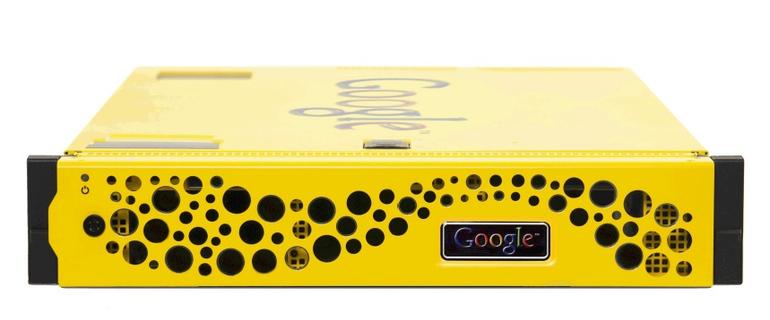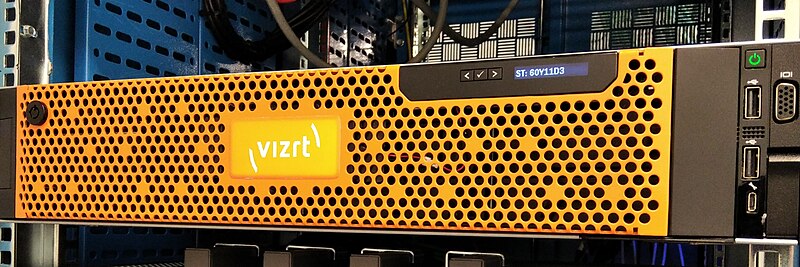Google Search Appliance (GSA) reached the end of its life in 2019. Thus, many organizations, whether public or private, are required to find a Google Search Appliance replacement.
Finding a Google Search Appliance replacement may seem like a daunting task. Setting up an on-premise device, such as GSA, from scratch has required technical expertise from hooking up and configuring the device to get the search running.
Let’s start from the beginning.
Table of Contents
What is Google Search Appliance?
Google Search Appliance is a piece of hardware coupled with Google’s algorithms used for indexing and searching the content from multiple sources, those of private and public servers. The device itself is a server in a yellow casing manufactured by DELL, and it looks like this:
GSA can index an impressive number of different content types. The search results can be filtered, and the users’ search requests can be analyzed. The user interface for GSA is the browser, and it can be accessed on a dedicated domain.
While GSA has served its users for a long time, Google has announced that it will discontinue maintenance and support for GSA in 2019 when the last of the customer support licenses expire. This leaves GSA customers without a search solution and an urgent need to find a replacement.
The change may seem daunting, as the Google Search Appliance has been a great investment. It entails installing GSA on-premises and configuring the network settings to connect it to the web and to the existing infrastructure. Needless to say, setting up a GSA requires technical expertise.
Setting up a new site search may not be as technically as an involved project as is the case with GSA. Many of the replacement options come as a service. This means that the service provider takes care of most of the technical details provided with support.
Google Search Appliance migration to AddSearch
Migrating from GSA, however, maybe a lot easier than you might think. You can acquire a fully-featured search solution as a service that provides features similar to GSA. Furthermore, the search as a service provides support for setting up the search as well as the development of new features GSA may have lacked.
If you’re considering migration to AddSearch, we have put together a list of questions that have often been considered during migration.
- Can I manage search results with AddSearch?
- Google Search Appliance didn’t need integration. How about AddSearch?
- Does AddSearch index content behind a login?
- Does AddSearch support the crawling and indexing of multiple domains and platforms?
- Does AddSearch support search filtering and faceted search filtering?
- Does AddSearch support user administration?
- Does AddSearch support indexing PDF and Microsoft Office documents?
- Does AddSearch provide support for migration?
1. Can I manage search results with AddSearch?
| AddSearch | Google Search Appliance | |
|---|---|---|
| Multiple domains | ✔ | ✔ |
| Result biasing | ✔ | ✔ |
| Filtering results | ✔ | ✔ |
| Synonyms | ✔ | ✔ |
| Segmenting the index | ✔ | ✔ |
| Document preview | ✔ | ✔ |
| UI Customization | ✔ | ✔ |
| Pinned results | ✔ | - |
| Widget view | ✔ | - |
| Promotions | ✔ | - |
Yes! You can take full advantage of your search to drive traffic to the most important pages of your website and fine-tune your search results to make sure your visitors find what they are looking for. While the technical solutions and the names of the features may vary between Google Search Appliance and AddSearch, the end result for the user making the searches is the same.
- Keymatch can be accomplished with Hidden keywords.
- Result biasing can be accomplished with Site areas.
- Filtering results can be accomplished with Category filters.
- Synonyms go by the same name.
- Document preview is realized as a thumbnail and a screen capture of the page.
- User Interface (UI) customization can be modified in the Dashboards Settings under Look & Feel.
AddSearch also has other features you can use to enhance the search results:
- Pinned results allow handpicking search results and arranging them for returning them first in the search results
- Widget view allows the user to get instant search results while typing. You can see the Widget view on the right corner of the screen.
- Promotions allow you to create temporary or permanent promotional banners that are displayed on top of the search results.
2. Google Search Appliance didn’t need integration. How about AddSearch?
Just like Google Search Appliance, AddSearch indexes domains by crawling, which means that no integration is needed. If you’re not familiar with what crawling and indexing are, here is a short description of how the process goes:
Crawling refers to a process of following and collecting links from a website. Crawling is carried out by an application called the crawler. The process, in short, proceeds as follows. The crawler
- visits a web page,
- searches the web pages for links to other web pages,
- follows the links to the other web pages and,
- iterates until it can’t find more links.
Indexing refers to the process where the content from web pages found by the crawler is saved to the database, which is organized as an index that can be accessed by the search engine.
Traditional crawling works on static websites, where the crawler can find the contents from the page source. AddSearch also supports AJAX crawling for Javascript-heavy websites where the contents are generated dynamically. To find out more, visit our earlier post on Ajax crawling.
3. Does AddSearch index content behind a login?
AddSearch can crawl and index content that requires a login and password, just like Google Search Appliance. However, there are some differences between AddSearch and GSA on the accessibility of the indexed content.
According to Google Search Appliance Help pages, GSA determines whether the user performing the search is authorized to view each document before it displays results. This means that for the user to be able to search the crawled and indexed content behind a login, he or she has to be logged in to the authorized area of the website.
AddSearch differs from GSA in that the services reside in the cloud unlike GSA, which is an on-premise device. Thus, filtering access to the authorized content differs from GSA.
4. Does AddSearch support the crawling and indexing of multiple domains and platforms?
Similarly to Google Search Appliance, AddSearch supports the crawling and indexing multiple domains which means that the content is accessible from a single search point. This is also referred to as a federated search.
As an on-premise device, Google Search Appliance can crawl and index multiple private domains that reside on the same premises. GSA can also crawl and index multiple domains that can be accessed from the internet.
As our previous article on federated search points out, crawling and indexing multiple domains is a crucial feature; the content is scattered across multiple SaaS platforms such as Shopify, Hubspot, Zendesk, and even DevOps-related Heroku.
5. Does AddSearch support search filtering and faceted search filtering?
Both AddSearch and Google Search appliances support enhancing the search results with search filtering and faceted search filtering.
Filtering in this context refers to including specific areas from a domain or domains in the search results and excluding others. For instance, you could use a filter that includes the blog posts in the search results.
Faceted filtering refers to a search where the user can narrow down the search results filtering with multiple filters that affect each other. An example of faceted search filtering would be to narrow down the search to blog posts from a single author with a specific date range.
6. Does AddSearch support user administration?
AddSearch and Google Search Appliance support user administration with user accounts that have different user privileges.
Google Search Appliance has two levels of user accounts. They are the administrators and the manager user accounts. By default, Google Search Appliance allows one administrator account on each search appliance device.
GSA administrators have privileges to create user accounts and access to system-level functions. Managers have access to functions for managing the content.
Similarly to GSA AddSearch has two levels of user accounts, those of administrator and the user account. All users have access to crawling, indexing and search-related functionalities which they can use to enhance the search results. All users have access to statistics as well.
In addition to the before mentioned, the administrators can manage users (add, remove, promote). As AddSearch operates using the SaaS business model, the administrator also has access associated to billing and contact information of the subscription.
7. Does AddSearch support indexing PDF and Microsoft Office documents?
Yes! AddSearch can index PDFs and doc, docx, ppt, pptx Microsoft Office documents.
8. Does AddSearch provide support for migration?
AddSearch provides prioritized support for migrating from GSA for enterprise customers. Planning and executing the migration usually takes several weeks and AddSearch’s support team works closely with the customer to make sure the search is deployed on time and delivers relevant results. AddSearch also provides tech and customer support after the migration.
In addition to the prioritized support, AddSearch supports all the customers with the documentation found from our pages. We have divided the support into Documentation, API references as well as the helpdesk where you can reach us via email.
Final thoughts
Replacing Google Search Appliance with AddSearch provides features you would expect from GSA – and more. It also comes with a dedicated team that provides you with their expertise which entails planning and executing the migration from GSA that matches your business goals. AddSearch can even come up with new features you were missing before.




